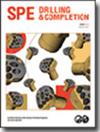Significant Surge and Swab Offshore Brazil Induced by Rig Heave during Drillpipe Connections
IF 1.2
4区 工程技术
Q3 ENGINEERING, PETROLEUM
引用次数: 0
Abstract
In this paper, we describe measured and simulated downhole pressure variations (“surge and swab”) during drillpipe connections when drilling an ultradeepwater well offshore Brazil on Bacalhau (former Carcará) Field. Floating rig motion caused by waves and swell (“rig heave”) induces surge and swab when the drillstring is suspended in slips to make up or break a drillpipe connection and topside heave compensation is temporarily deactivated. This is a known issue in regions with harsh weather, such as the North Sea, where pressure oscillations of up to 20 bar have been reported during connections. Recorded downhole drilling data from Bacalhau Field reveals significant pressure oscillations downhole (in the same order of magnitude as in the North Sea) each time the drillstring was suspended in slips to make a connection in the subsalt 8½-in. section of the well. Mud losses were experienced around the same well depth, and they might have been caused by surge and swab. Measured surge and swab pressure variations have been reproduced in an advanced proprietary surge and swab simulator that considers rig heave, drillpipe elasticity, well friction, non-Newtonian drilling mud, well trajectory, and geometry. Moreover, findings in this paper suggest that surge and swab was in fact significantly higher than recorded by the measurement while drilling (MWD) tool. The true magnitude of surge and swab is not captured in the recorded MWD data due to low sampling frequency of the downhole pressure recording (one measurement every 6 seconds, a standard downhole pressure sampling rate used on many operations today). This work shows that surge and swab during drillpipe connections on floaters may challenge the available pressure window for some wells, even in regions with calm weather such as Brazil. Managed pressure drilling (MPD) is a technique that improves control of the downhole pressure. It is, however, not possible to compensate fast downhole pressure transients, such as heave-induced surge and swab, using MPD choke topside. This is due to the long distance between the choke and the bit, which translates into a time delay in the same order of magnitude as typical wave and heave periods. A downhole choke combined with continuous circulation is one of the potential solutions. Surge and swab during drillpipe connections can result in a loss or an influx and should be considered in the well planning phase when mud weight, section lengths, etc. are selected.巴西海上钻杆连接过程中由钻机隆起引起的显著浪涌和抽汲
在本文中,我们描述了在巴西Bacalhau(原carcar)油田钻井时,在钻杆连接过程中测量和模拟的井下压力变化(“浪涌和抽吸”)。当钻柱悬挂在卡瓦中以弥补或断开钻杆连接时,由波浪和膨胀引起的浮式钻机运动(“钻机隆起”)会引起井喷和刮擦,而上部隆起补偿暂时失效。这在恶劣天气地区是一个众所周知的问题,例如北海,在连接过程中压力波动高达20 bar。Bacalhau油田记录的井下钻井数据显示,每次将钻柱悬挂在卡瓦中进行8 - 1 / 2 -in盐下连接时,井下压力都会出现明显的波动(与北海相同的数量级)。井的一部分。在相同的井深附近也发生了泥浆漏失,这可能是由涌浪和抽汲引起的。在先进的专有的喘振和抽汲压力模拟器中,可以重现测量到的喘振和抽汲压力变化,该模拟器考虑了钻机隆起、钻杆弹性、井摩擦、非牛顿钻井泥浆、井轨迹和几何形状。此外,本文的研究结果表明,浪涌和抽汲实际上比随钻测量(MWD)工具记录的要高得多。由于井下压力记录的采样频率较低(每6秒测量一次,这是当今许多作业中使用的标准井下压力采样率),因此记录的MWD数据中无法捕捉到井喷和抽汲的真实强度。这项工作表明,在浮子钻杆连接过程中,井喷和抽汲可能会挑战一些井的可用压力窗口,即使在巴西等天气平静的地区也是如此。控压钻井(MPD)是一种改善井下压力控制的技术。然而,使用MPD节流器无法补偿快速的井下压力瞬变,例如升沉引起的浪涌和抽汲。这是由于扼流圈和钻头之间的距离较长,这意味着与典型的波浪和起伏周期相同数量级的时间延迟。井下节流阀与连续循环相结合是一种潜在的解决方案。在钻杆连接过程中,井喷和抽汲可能会导致漏失或井涌,因此在选择泥浆比重、井段长度等时,应考虑到这一点。
本文章由计算机程序翻译,如有差异,请以英文原文为准。
求助全文
约1分钟内获得全文
求助全文
来源期刊

SPE Drilling & Completion
工程技术-工程:石油
CiteScore
4.20
自引率
7.10%
发文量
29
审稿时长
6-12 weeks
期刊介绍:
Covers horizontal and directional drilling, drilling fluids, bit technology, sand control, perforating, cementing, well control, completions and drilling operations.
 求助内容:
求助内容: 应助结果提醒方式:
应助结果提醒方式:


